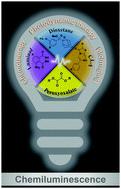当前位置:
X-MOL 学术
›
Chem. Soc. Rev.
›
论文详情
Our official English website, www.x-mol.net, welcomes your
feedback! (Note: you will need to create a separate account there.)
Chemiluminescence for bioimaging and therapeutics: recent advances and challenges.
Chemical Society Reviews ( IF 40.4 ) Pub Date : 2020-09-15 , DOI: 10.1039/d0cs00348d Mingwang Yang 1 , Jiaguo Huang , Jiangli Fan , Jianjun Du , Kanyi Pu , Xiaojun Peng
Chemical Society Reviews ( IF 40.4 ) Pub Date : 2020-09-15 , DOI: 10.1039/d0cs00348d Mingwang Yang 1 , Jiaguo Huang , Jiangli Fan , Jianjun Du , Kanyi Pu , Xiaojun Peng
Affiliation

|
Chemiluminescence, the generation of light through chemiexcitation as a result of chemical reactions, has emerged as a novel tool for bioimaging and therapy in vivo. Due to the elimination of external optical excitation, it can effectively avoid background autofluorescence existing in fluorescence techniques, providing extremely high signal-to-noise ratios and sensitivity in bioimaging. Furthermore, in situ emitted photons can replace traditional excitation light to construct chemiexcited photodynamic therapy or drug release systems for the monitoring and treatment of deeply seated diseases or tumors. In this tutorial review, we will focus on the recent advancements of chemiluminescent platforms based on luminophore substrates including luminol and its derivatives, cypridina luciferin analogs, peroxyoxalates, and dioxetanes, and systematically summarize the design principles, sensing mechanisms, and bioimaging and therapeutic applications of representative chemiluminescent probes as well as theranostic agents. Finally, the potential challenges and perspectives of chemiluminescent platforms for bioimaging and therapeutics are also discussed.
中文翻译:

用于生物成像和治疗的化学发光:最新进展和挑战。
化学发光是由于化学反应而由化学激发产生的光,已成为一种用于体内生物成像和治疗的新型工具。由于消除了外部光学激发,它可以有效避免荧光技术中存在的背景自发荧光,从而在生物成像中提供极高的信噪比和灵敏度。此外,就地发射的光子可以代替传统的激发光,以构建化学激发的光动力疗法或药物释放系统,以监测和治疗深层疾病或肿瘤。在本教程的回顾中,我们将重点介绍基于发光体底物的化学发光平台的最新进展,这些发光体包括鲁米诺及其衍生物,赛普卢迪丝荧光素类似物,过氧草酸酯和二氧杂环丁烷,并系统地总结了其的设计原理,传感机制以及生物成像和治疗应用代表性的化学发光探针以及治疗试剂。最后,还讨论了用于生物成像和治疗的化学发光平台的潜在挑战和前景。
更新日期:2020-10-05
中文翻译:

用于生物成像和治疗的化学发光:最新进展和挑战。
化学发光是由于化学反应而由化学激发产生的光,已成为一种用于体内生物成像和治疗的新型工具。由于消除了外部光学激发,它可以有效避免荧光技术中存在的背景自发荧光,从而在生物成像中提供极高的信噪比和灵敏度。此外,就地发射的光子可以代替传统的激发光,以构建化学激发的光动力疗法或药物释放系统,以监测和治疗深层疾病或肿瘤。在本教程的回顾中,我们将重点介绍基于发光体底物的化学发光平台的最新进展,这些发光体包括鲁米诺及其衍生物,赛普卢迪丝荧光素类似物,过氧草酸酯和二氧杂环丁烷,并系统地总结了其的设计原理,传感机制以及生物成像和治疗应用代表性的化学发光探针以及治疗试剂。最后,还讨论了用于生物成像和治疗的化学发光平台的潜在挑战和前景。











































 京公网安备 11010802027423号
京公网安备 11010802027423号